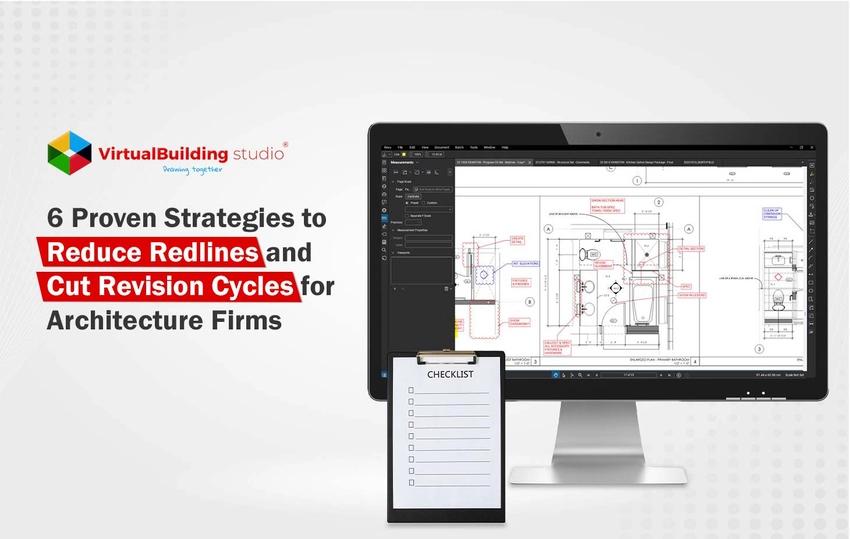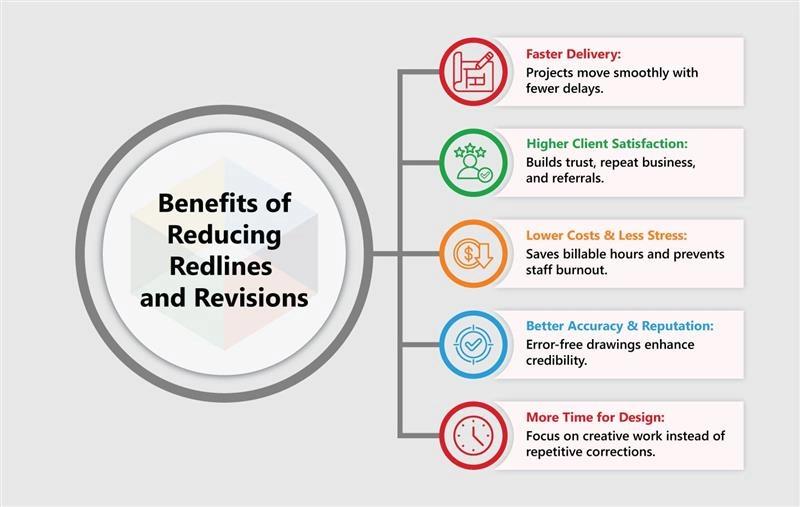
Introduction: Why Redlines Hurt Architectural Firms
The process of architectural drafting often entails numerous redlines and seemingly never-ending revisions that are more than just a headache. It affects the schedule, budget, and client relationship. For the architectural firm in the United States, this is even more pronounced because:
- With fewer staff, revisions take away design time.
- Due to tight budget, rework becomes expensive and eats into profit.
- With fewer resources, there is always a little room for recurring errors or miscommunication.
- If revisions continue to increase, the project slows down, client gets frustrated, and often firms lose their competitive advantage.
In this blog, we will discuss tactical strategies for minimizing redlines and revisions in a way that facilitates architectural firms to deliver drawings faster with greater accuracy while still protecting their quality expectations.
Understanding Redlines and Revisions
Redlines in architectural drawings refer to notes or corrections on plans, elevations, sections, or MEP layouts that represent changes or suggest corrections. Redlines can be provided by clients, consultants, code reviewers, or an internal QA team that identifies issues. Redlines typically identify a missing detail, a conflict in coordination, or a compliance issue.
Revision Cycle typically arise from:
- Miscommunications between architects, clients, and contractors.
- Overlooking standard protocols, like inconsistent templates or drafting practices.
- Errors in drawings, like missed dimensions or conflicts.
- Client's expectation is not clear, resulting in changes in scope at the mid-project.
In any architectural firm in the US, excessive redlines, corrections, reconciliation, or revisions can quickly burn through resources. It reduces productivity and increases project cost.
Why Redlines Are More Impactful for Architects in the US
When it comes to the impact of redlines and repeated revisions, the effect is more pronounced for smaller architectural firms than for those firms that are staffed with larger teams. Each hour that is spent on unnecessary revisions is an hour that is taken away from the design quality and client service.
There are key challenges including:
- Less staff: Most small drafting teams handle multiple projects at a time, and if the number of revisions is excessive, it can burden the team's capacity.
- Budget constraints: Architecture design and planning firms cannot absorb the cost of take-backs and delays in delivering design documents like larger firms can.
- Client Expectation: Repeated business and referrals help grow firms, but extended revision cycles erode clients' trust.
- Reputation: Architecture firms cannot afford consistent mistakes and delays; trustworthiness is essential to compete against larger firms.
This means, reducing revisions will have a direct effect on profitability and growth in the long run.
Understanding the Root Causes of Excessive Redlines
| Root Cause | Explanation | Impact on Architectural Firms |
|---|---|---|
| Communication Breakdowns | Misalignment between architects, clients, and consultants often leads to conflicting instructions or overlooked details. | Creates repeated back-and-forth cycles, stretching limited staff capacity. |
| Incomplete Briefings & Scope Creep | Initial requirements are not fully captured, or clients request changes mid-project without formal documentation. | Adds unplanned drafting work, delaying timelines and increasing costs. |
| Lack of Standardized Processes | Inconsistent templates, naming conventions, or drafting protocols across projects. | Increases errors, reduces efficiency, and makes collaboration harder. |
| Technology Gaps | Reliance on outdated CAD tools or the absence of collaborative platforms. | Slows coordination, increases manual errors, and reduces competitiveness. |
| Insufficient Quality Control | Few internal review stages or missing redline reduction practices. | Few internal review stages or missing redline reduction practices. |
| Client Education Deficits | Clients often misunderstand design stages and documentation requirements. | Results in unrealistic expectations, unclear feedback, and unnecessary rework. |
Proven Strategies to Reduce Redlines and Revision Cycles
Cutting down on redlines is less about working harder and more about working smarter. For architecture firms in the United States, making drafting work more efficient will save time and money, and protect client relationships. Below are tested methods for reducing revisions considerably while improving accuracy and efficiency.
Strategy 1: Establish A Defined Project Scope and Client Expectations
- Document everything at the beginning: Document the functional, aesthetic, and regulatory needs of the client before even starting the drawing process, so there is no ambiguity later on.
- Hold kickoff meetings: This ensures the stakeholders are on the same page when it comes to design intent, project scope, and deliverables on the first day.
- Use visuals: 3D renders, diagrams, and sketches of projects assist in enabling clients to visualize concepts earlier on and reduce the chance of miscommunication.
Having a clear scope of work allows for fewer surprises during the project lifecycle and reduces the instances of clients wanting something changed because they had unclear expectations.
Strategy 2: Standardize Drafting Processes
- Firm-wide templates and checklists: Use the same line weights, annotation style, and title blocks to minimize errors.
- Maintain CAD/BIM standards: Develop and enforce clear modeling and documentation standards.
- Train all team members: Make sure, even the junior drafters follow standard operating procedures.
Standardization allows you to ensure accuracy across all drawings and reduces errors, which enhances clients' expectations.
Strategy 3: Leverage technologies and software
- Collaborative drafting tools: Use tools such as Revit, AutoCAD with cloud plugins, or Bluebeam to identify issues sooner.
- Implement cloud-based collaboration platforms: Work with architects, consultants, and clients in real-time, so they can review and work on the same files, reducing miscommunication.
- Automated clash detection: BIM-based tools for Clash detection will flag conflicts with other trades like structure, MEP, etc., prior to the drawings reaching the review stages.
Technology reduces human error and shortens the revision cycle by catching and addressing flaws and conflicts upstream.
Strategy 4: Optimize Internal Review Processes
- Peer review before submission: It's often a fresh set of eyes that finds errors or omissions that the drafter doesn't catch.
- Tiered review process: Junior staff drafts the documents, and senior staff reviews for accuracy of drawings, code compliance, and constructability.
- Encourage internal redline reduction: An internal redline process is a learning mechanism to elevate and standardize quality control and to reduce external redlining.
Internal review workflows ensure we present the client with a higher-level finish, with fewer subsequent revisions.
Strategy 5: Strengthen Client Communication
- Share in-process updates: Share content updates in small sections, rather than sharing a near-final finished product. This way, there are no major revisions.
- Provide a visual review process: Using a collaborative platform that has markup and commenting functions, so that the feedbacks are tracked accurately.
- Encourage consolidated feedback: Help the client prepare their feedback as consolidated feedback rather than scattered comments in emails.
Effective communication helps set the client in the design process, and there are fewer revisions due to a lack of expectation alignment.
Strategy 6: Engage with Competent Drafting Resource (On-Demand or Outsourced)
- Flexible staffing: For resource challenges in architecture firms, accessing a talented drafter on a requirement basis during busy periods will help maintain quality.
- Outsource the complicated drafting: Reliable architectural drafting services providers who can focus on complex project delivery allow firms to reduce workload internally.
- Consistency in delivery without burnout: An on-demand drafter engaged on a project allows the project team to deliver faster while working on managing design quality more effectively.
In any case, support from dedicated architects for drafting means firms can scale efficiently and ultimately manage their revision cycle.
Along with establishing good scoping, developing standardization in your processes, accessing modern technology and tools, setting up revisions and reviews, good communication, and effective staffing will lend architecture firms a significant advantage by reducing redlines. Ultimately, faster and cheaper delivery that aligns with quality isn't the only benefit: utilizing these techniques simply results in enhanced client satisfaction, all of which is valuable for competition in the United States.

Streamline Your Drafting - Minimize Redlines and Maximize Efficiency
Fewer redlines translates to more efficient projects, lower cost, and happier clients. For architectural firms in the US, managing the drafting process correctly, communicating better, and using technology can improve their competitiveness and keep up with the potential clients’ growing need for architectural services. Using the strategies discussed above, like clear scoping, standardizing processes, internal reviews, and structured feedback, can help firms significantly limit revisions and improve workflow efficiency.
Don’t let redlines slow you down!
